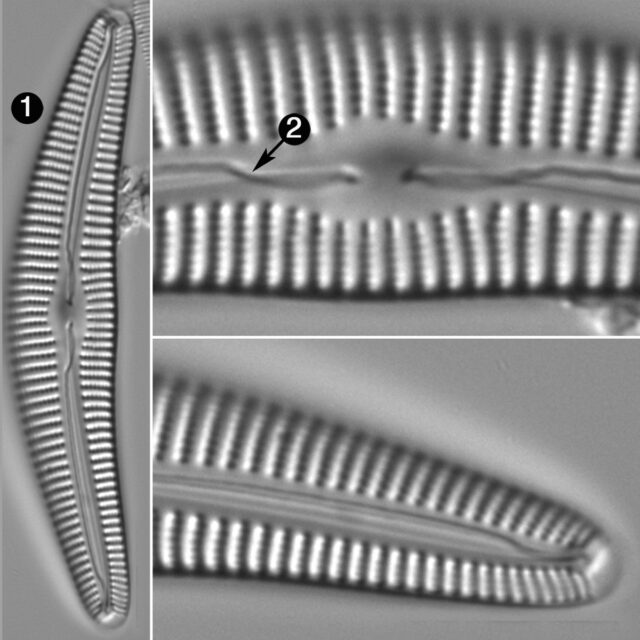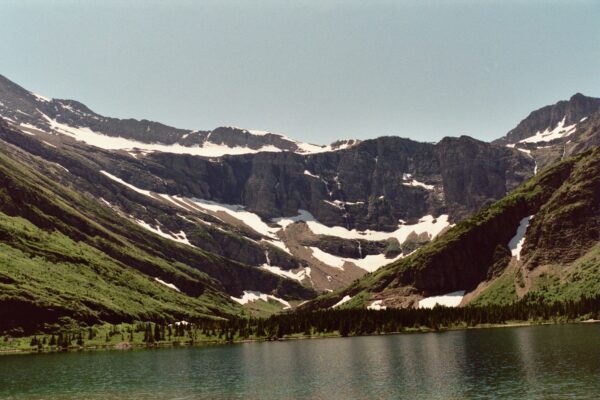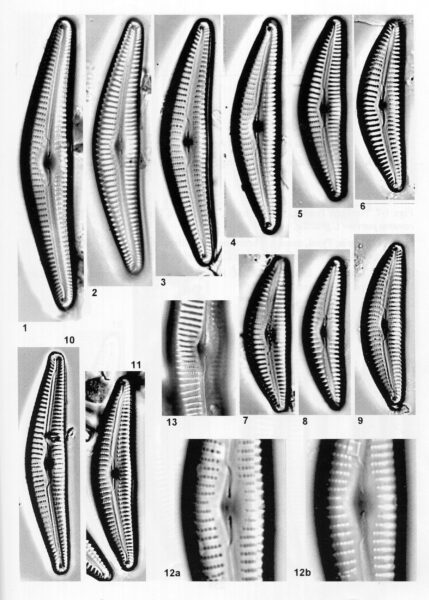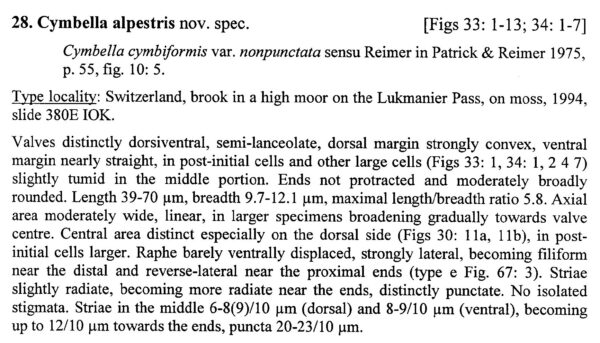Cymbella alpestris
-
Category
-
Length Range40.1-65.1 µm
-
Width Range9.0-11.7 µm
-
Striae in 10 µm8-10 at the valve center, up to 12 at the apices
-
Reported AsCymbella cymbiformis var. nonpunctata (Patrick & Reimer 1975, p. 55, pl. 10, fig. 5)
-
ContributorLoren Bahls - May 2016
-
ReviewerRex Lowe - Jun 2016
Identification
Description
Valves are dorsiventral with rounded ends that may be weakly protracted and upturned in some specimens. Dorsal margin is strongly arched; ventral margin is weakly concave with a tumid center. The axial area is about 1/4th the valve width and merges with a somewhat wider elliptic central area. The raphe is distinctly lateral, becoming reverse-lateral near the proximal ends and filiform near the terminal ends. Proximal raphe ends are deflected ventrally and tipped with weakly inflated pores. Distal raphe ends are deflected dorsally at a 45 degree angle and do not bisect the terminal pore fields. Striae are radiate, becoming more strongly radiate near the valve apices. Striae are distinctly punctate with areolae that number 20-25 in 10 µm. Isolated stigmata are absent.
Krammer (2002) considers this taxon to be synonomous with C. cymbiformis var. nonpunctata Fontell sensu Reimer in Patrick & Reimer (1975).
Autecology
Cymbella alpestris has been recorded from several springs, lakes and wetlands in northern Montana and North Dakota. All of these sites have experienced glaciation in the past, either by mountain or continental glaciers. By contrast, C. hantzschiana may be found in both glaciated and unglaciated regions. Besides cool temperatures, the waters that support C. alpestris are all alkaline, with pH values ranging from 8.04 to 9.60. This species can tolerate a wide range of electrical conductivity, with measured values ranging from 129 µS/cm in Bullhead Lake, Glacier National Park (photo below) to 1693 µS/cm in a kettle lake in North Dakota on the Northwest Glaciated Plains. Cymbella alpestris was described from a population in the Swiss Alps and has also been reported from Scandinavia.
-
Size Range, µm3
-
Motility
-
Attachment
-
Habitat
-
Colony
-
Waterbody
- Learn more about this
Citations & Links
Citations
Links
-
Index Nominum Algarum
Cite This Page
Bahls, L. (2016). Cymbella alpestris. In Diatoms of North America. Retrieved November 21, 2024, from https://diatoms.org/species/cymbella_alpestris
Responses
The 15 response plots show an environmental variable (x axis) against the relative abundance (y axis) of Cymbella alpestris from all the stream reaches where it was present. Note that the relative abundance scale is the same on each plot. Explanation of each environmental variable and units are as follows:
ELEVATION = stream reach elevation (meters)
STRAHLER = distribution plot of the Strahler Stream Order
SLOPE = stream reach gradient (degrees)
W1_HALL = an index that is a measure of streamside (riparian) human activity that ranges from 0 - 10, with a value of 0 indicating of minimal disturbance to a value of 10 indicating severe disturbance.
PHSTVL = pH measured in a sealed syringe sample (pH units)
log_COND = log concentration of specific conductivity (µS/cm)
log_PTL = log concentration of total phosphorus (µg/L)
log_NO3 = log concentration of nitrate (µeq/L)
log_DOC = log concentration of dissolved organic carbon (mg/L)
log_SIO2 = log concentration of silicon (mg/L)
log_NA = log concentration of sodium (µeq/L)
log_HCO3 = log concentration of the bicarbonate ion (µeq/L)
EMBED = percent of the stream substrate that is embedded by sand and fine sediment
log_TURBIDITY = log of turbidity, a measure of cloudiness of water, in nephelometric turbidity units (NTU).
DISTOT = an index of total human disturbance in the watershed that ranges from 1 - 100, with a value of 0 indicating of minimal disturbance to a value of 100 indicating severe disturbance.

Cymbella alpestris
- Valves up to 70 µm long
- Stigmata lacking
- Proximal raphe ends reverse-lateral
- Striae 8-12 in 10 µm
- Areolae 20-25 in 10 µm
Valves are dorsiventral and large, up to 70 µm long. The central area is small and isolated stigmata are absent. Proximal raphe ends are reverse-lateral and deflected ventrally. Striae number 8-12 in 10 µm and areolae number 20-25 in 10 µm.
 Diatoms of North America
Diatoms of North America








